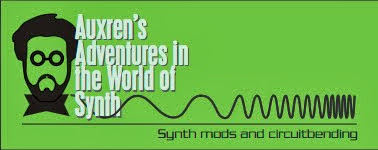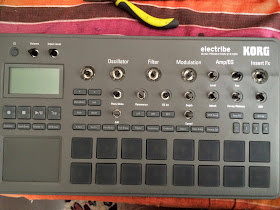My Electribe 2 might just be my favorite piece of gear. It is now the center of my 'Battlestation'. It has allowed me to stop using my computer and rely on it to control my synths. I connect the USB from the Electribe 2 to a USB hub connected to my iConnectMIDI4+ and it can control all my synths at the same time. Just set each synth to a different channel and you are in business.
Currently, the Electribe via the iConnectMIDI4+ controls my Eurorack (via Yarns), Prophet '08, Minibrute, MS-20 mini, and Slim Phatty. I also connected my Korg M50 keyboard to the Electribe to use as a master keyboard controller. With this setup, I can record MIDI data to the Electribe via the M50 and play it back to any of the other synths.
The sounds in the Electribe aren't too bad, but I usually end up relying on the sounds of my other hardware synths. The only time I use all internal sounds is when I am out of the house and using the Electribe via battery power somewhere. I've taken it to the beach and had a fun time watching the waves and programming a surf rock type song. When I got home, I connected the Electribe back to my setup and ditched the internal sounds for analog sounds while still using the MIDI sequencer. All in all. I love it.
As with the rest of my gear, I just had to pop the Electribe open incase there were some interesting patch points and for just learning about their manufacturing technique. The Electribe was quite easy to open and can be easily repairable.
The knobs come of quite easily. The back unscrews and comes off without a problem. Note that there is a screw in the battery box too.
There are 3 PCBs in the Electribe. The one directly below is the brains of the operation. The other PCB is the control PCB with the knobs and buttons along with a small jack PCB for the 1/4" jacks.
After removing the main 'brain' PCB, you can see that it packs a good amount of power.
The DSP used is a Blackfin by Analog Devices and packs a good amount of arithmetic power. Compared to the Sharc DSP used in Strymon gear, the Blackfin is quicker with it's functionality due to it's multiple ALUs and faster clocking (300MHz vs 50MHz), although the Sharc excels in floating point math.
The main processor is a Texas Instruments Sitara Processor (AM1802) ARM9 processor which can pack a heavy punch. The other large chip towards the top of the picture is the SK Hynix SDRAM for the TI ARM9.
An Analog Devices Quad Buck Regulator (ADP5052) is used in the power supply section.
Flex PCB coming out from the screen connecting to the 'brain' board.
PCB for the 1/4" jacks.
The button/knob board contains a Cypress (formerly Spansion) Cortex M3 based processor. This chip has 12 channels of 12-bit ADCs, which makes me think it handles all the sampling of the knobs and buttons so relieve the TI chip from some of it's duties.
The screen and touch panel are definitely repairable; they are loose once you remove the button/knob board.


























